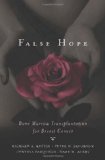In the late 1980s, a promising new therapy for breast cancer emerged: high-dose chemotherapy with autologous bone marrow transplantation or HDC/ABMT. By the 1990s, it had burst upon the oncology scene and disseminated quickly before having been meticulously evaluated. By the time published research showed that the process was ineffective, much more than 30,000 ladies had received the treatment, shortening their lives and adding to their suffering. This book tells of the rise and demise of HDC/ABMT f
List Value: $ 39.95
Price: [wpramaprice asin=”0195187768″]


Leave a Reply
You must be logged in to post a comment.